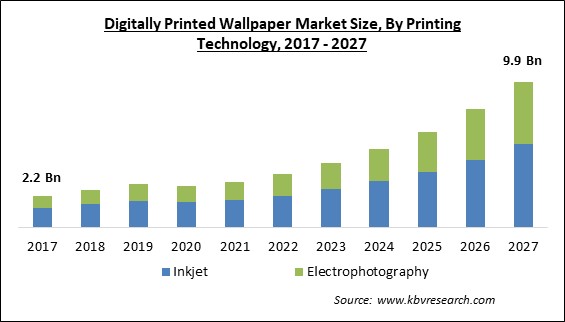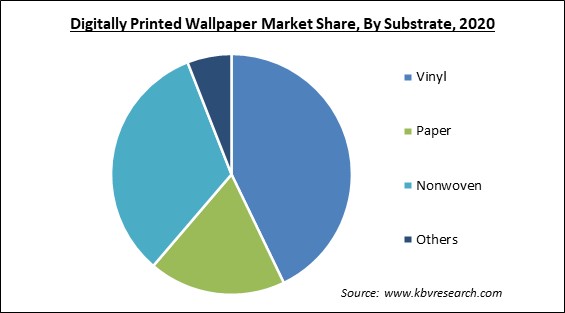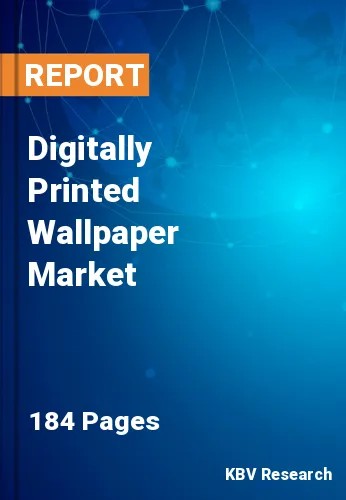The Global Digitally Printed Wallpaper Market size is expected to reach $9.9 billion by 2027, rising at a market growth of 21.4% CAGR during the forecast period.
Digital printing is a vital component of the graphics industry. Because noncontact printing is used in digital wallpaper technologies, designers and developers have additional substrate options. This also eliminates visual distortion, which is common in the analogue process. In addition, digital printing is becoming increasingly popular, resulting in more development and acceptance of digitally printed wallpaper technology.
Wallpapers that have been digitally printed are gaining traction in the market. They serve a variety of purposes by providing a number of advantages, the most important of which is that their distinctive surfaces may be printed by a wide range of printers. Patterns, photos, and designs are reproduced using both solvent and UV printing methods, resulting in a high-quality product.
Digitally printed wallpaper is an image or mural printed on a computer and utilized as a wall mural in both home and commercial settings. Moreover, these wallpapers are also utilized for interior decorating on the walls of public and private buildings, as well as in transportation vehicles. These wallpapers are usually sold in roll form by digital wallpaper suppliers and are adhered to the wall with sticky glue. Nonwoven, vinyl, recycled paper, watermarked paper, coated paper, and special papers are used to create these wallpapers. Laser printing and inkjet printing, often known as electro-photography, are two types of printing technology.
Rapid urbanization in many countries leads to significant investment in the construction sector by both domestic and international businesses, particularly in residential developments. Additionally, interior designers and developers frequently employ digitally printed wallpapers in remodeling and renovation projects. In addition, growing living standards and increased demand for new homes are expected to drive demand for digitally printed wallpapers in the near future.

The COVID-19 had spread across major Asian, European, and North American countries, posing a threat to the industry for digitally printed wallpaper, as most global enterprises have offices in these areas. The supply chain had been disrupted by COVID-19, which had halted market expansion due to a scarcity of raw materials and people. As a result of the strict lockdown guidelines in major countries, production facilities for wallpaper substrates and other raw materials were shut down, as these were not considered critical products. The COVID-19 pandemic wreaked havoc on the global construction industry, affecting material and labor supply and costs, which are two of the most expensive components of construction projects.
Digitally printed wallpapers are more cost-effective than interior paint and improve the aesthetic appeal of walls. In addition, better aesthetics are in high demand, particularly in residential development. Moreover, digitally illustrated wallpapers enhance the aesthetic appeal of wall space while also preserving it from damage. For example, some wallpapers, such as grass-cloth printed on a fabric backing, can be installed on rough surfaces, helping to protect structures from the elements while also keeping their visual appeal. Aside from that, digitally printed wallpapers have a significantly longer lifespan than traditional paintings.
The utilization of digitally printed wallpapers is not just limited to the home. Digital wallpapers are in high demand in the commercial sector, including malls, gyms, spas, showrooms, hospitals, and other locations. In addition, many companies have started adopting customized wallpapers to make business interiors that symbolize the brand due to the recent advancements in digital printing. Moreover, colorful rooms and office design have also been shown to boost productivity and efficiency. The graphics can be used for marketing in workplaces and commercial settings. In recent years, there is a demand for a better visual appearance of offices. Further, the construction industry's ready-to-live and furnished homes are the key trends of the industry.
Printing laws, such as the European Environmental Legislative Framework, ensure that volatile organic compound emissions are kept under control. In addition, the printing industry in Europe is dedicated to lowering carbon dioxide emissions and assisting in the reduction of carbon footprints. Moreover, REACH (Registration, Evaluation, Authorization, and Restriction of Chemicals) laws apply to the chemicals used in the manufacture of wallpapers, such as the usage of additives like plasticizers in the manufacture of flat and expanded vinyl wallpapers. When compared to paper-based wallpapers, vinyl-based wallpapers are less environmentally friendly and more difficult to recycle.

Based on Printing Technology, the market is segmented into Inkjet and Electrophotography. In 2020, the Inkjet segment procured the maximum revenue share of the Digitally Printed Wallpaper Market. This is because of the introduction of a high-speed, commercial color printing inkjet system which is credited with the expansion of this technology. Moreover, good print sizes, printing speed, resolution, rapid setup, low turnaround time, and reliability are among the other elements driving inkjet printer acceptance.
Based on Substrate, the market is segmented into Vinyl, Paper, Nonwoven, and Others. The Nonwoven segment held a significant revenue share of the Digitally Printed Wallpaper Market in 2020. This owing to a variety of advantages such as tear resistance, easy washability, and quick installation and removal. In addition, one of the primary factors that have sparked consumer interest in non-woven wallpapers is the strong trend of do-it-yourself. These wallpapers are simple to install and have tear- and water-resistant properties, as well as are breathable, which prevents wall mold. Additionally, because the vapors aren't trapped between the wall and the paper, these are acceptable for bathrooms and kitchens.
Based on End User, the market is segmented into Non-residential, Residential, and Automotive & Transportation. In 2020, the Non-residential segment obtained the biggest revenue share of the Digitally Printed Wallpaper Market. This is because of the expansion in the number of high-traffic areas like pubs, clubs, and restaurants around the world. Moreover, the ongoing construction of commercial projects around the world would boost the demand for home décor products like wallpaper in the upcoming years.
| Report Attribute | Details |
|---|---|
| Market size value in 2020 | USD 2.8 Billion |
| Market size forecast in 2027 | USD 9.9 Billion |
| Base Year | 2020 |
| Historical Period | 2017 to 2019 |
| Forecast Period | 2021 to 2027 |
| Revenue Growth Rate | CAGR of 21.4% from 2021 to 2027 |
| Number of Pages | 184 |
| Number of Tables | 350 |
| Report coverage | Market Trends, Revenue Estimation and Forecast, Segmentation Analysis, Regional and Country Breakdown, Companies Strategic Developments, Company Profiling |
| Segments covered | Printing Technology, Substrate, End User, Region |
| Country scope | US, Canada, Mexico, Germany, UK, France, Russia, Spain, Italy, China, Japan, India, South Korea, Singapore, Malaysia, Brazil, Argentina, UAE, Saudi Arabia, South Africa, Nigeria |
| Growth Drivers |
|
| Restraints |
|
Based on Regions, the market is segmented into North America, Europe, Asia Pacific, and Latin America, Middle East & Africa. In 2020, the Asia-Pacific emerged as the dominating region in the overall Digitally Printed Wallpaper Market by collecting the largest revenue share. The market for digitally printed wallpaper in this region is being fuelled by a growth in the number of new dwelling units, an increase in desire for less expensive interior décor, an increase in population, and massive infrastructure improvements. In addition, better economic conditions in developing countries, urbanization and industrialization, rising disposable income, and the availability of inexpensive labor have all contributed to the growth of the regional market.
Free Valuable Insights: Global Digitally Printed Wallpaper Market size to reach USD 9.9 Billion by 2027
The market research report covers the analysis of key stake holders of the market. Key companies profiled in the report include A.S. Création Tapeten AG, 4Walls, Muraspec Group, Tapetenfabrik Gebr. Rasch GmbH & Co. KG, Graham and Brown Ltd., Astek, Inc., Great Wall Custom Coverings, The Printed Wallpaper Company, John Mark ltd., and Marshalls.
By Printing Technology
By Substrate
By End User
By Geography
The digitally printed wallpaper market size is projected to reach USD 9.9 billion by 2027.
Growing utilization in commercial and marketing are driving the market in coming years, however, chemicals in wallpapers are subject to strict legislative norms limited the growth of the market.
A.S. Création Tapeten AG, 4Walls, Muraspec Group, Tapetenfabrik Gebr. Rasch GmbH & Co. KG, Graham and Brown Ltd., Astek, Inc., Great Wall Custom Coverings, The Printed Wallpaper Company, John Mark ltd., and Marshalls.
The Vinyl segment acquired maximum revenue share in the Global Digitally Printed Wallpaper Market by Substrate 2020, thereby, achieving a market value of $4.1 billion by 2027.
The Asia Pacific market dominated the Global Digitally Printed Wallpaper Market by Region 2020, and would continue to be a dominant market till 2027.
Our team of dedicated experts can provide you with attractive expansion opportunities for your business.

